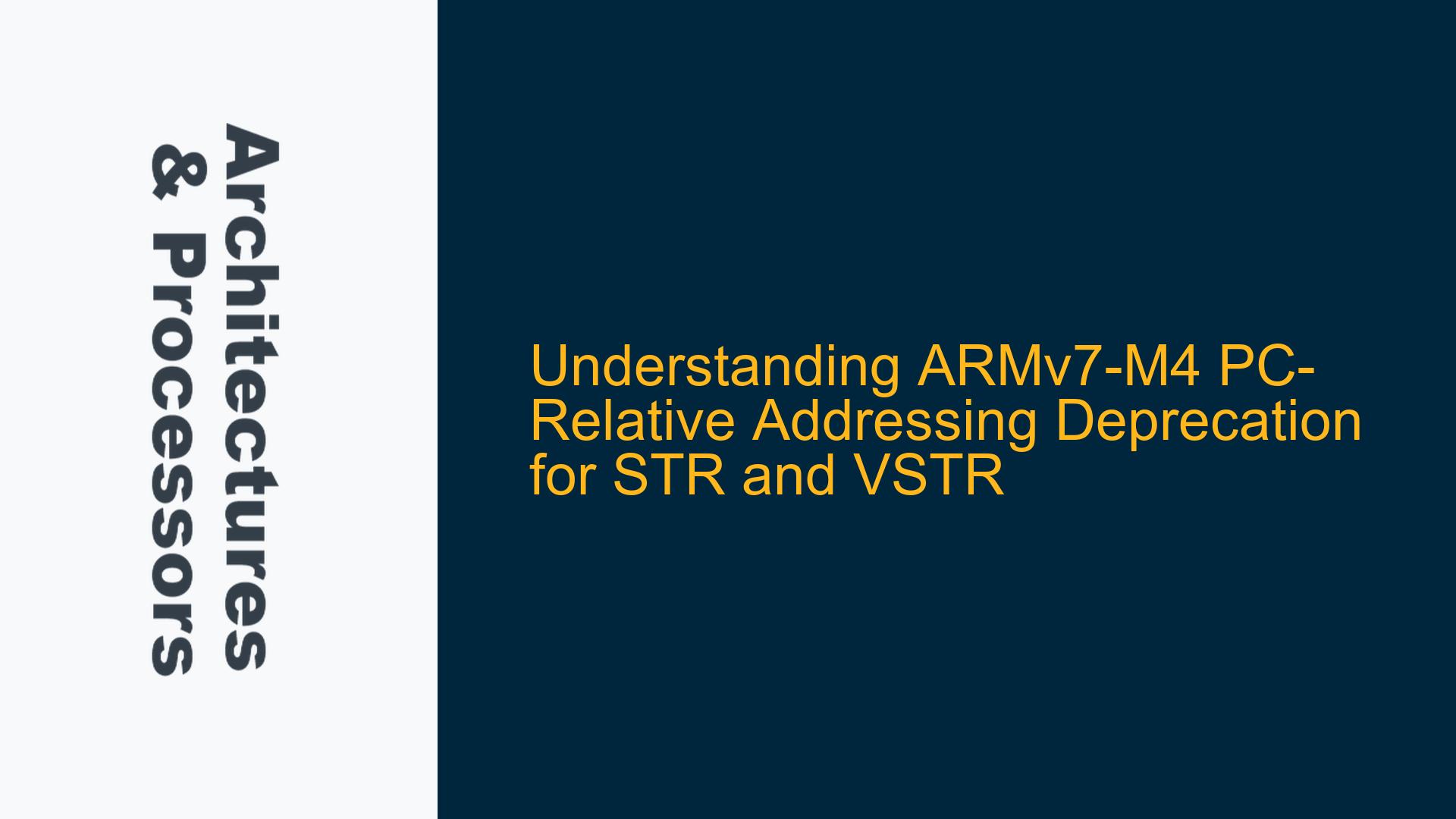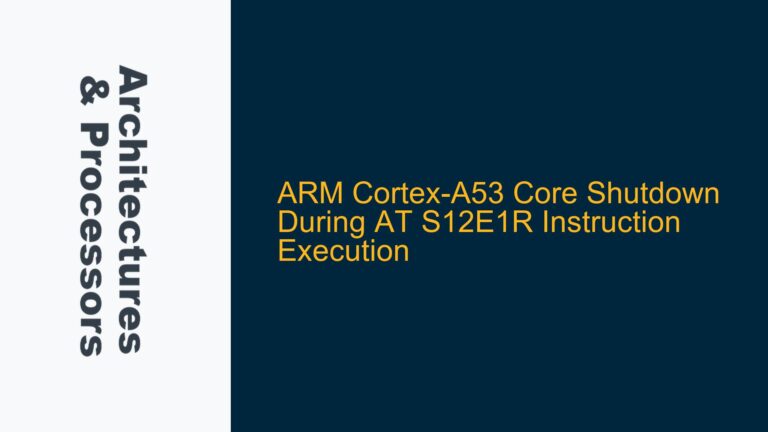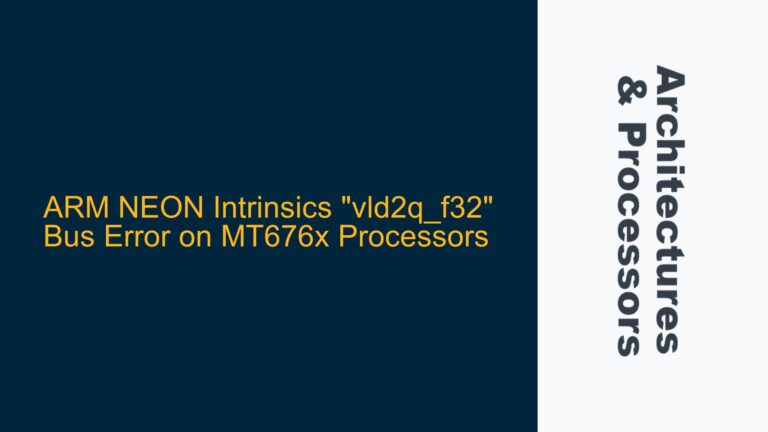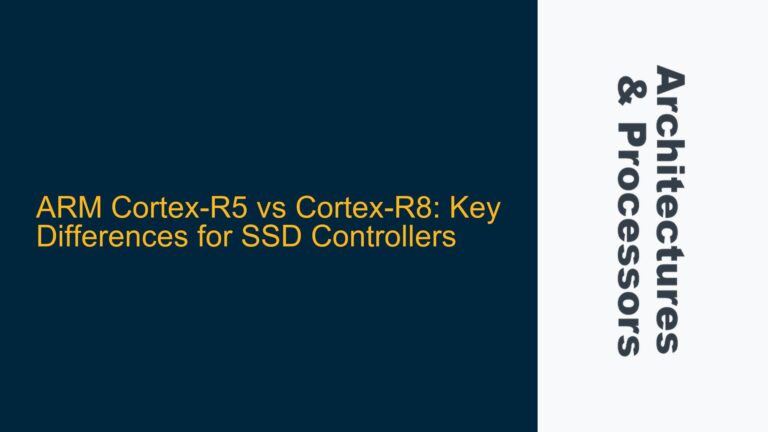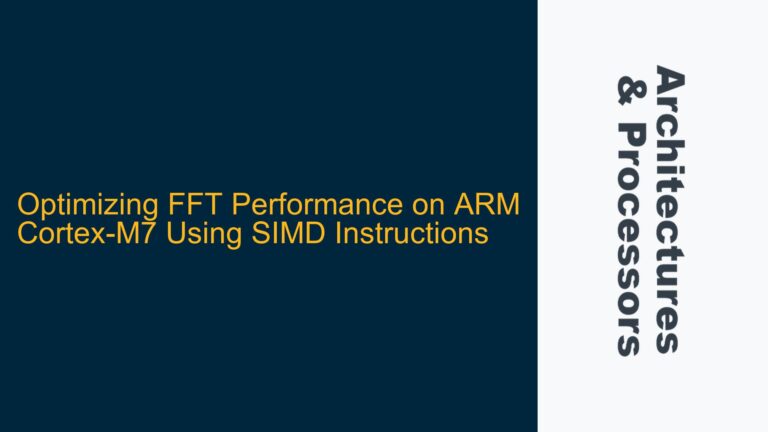ARMv7-M4 PC-Relative Addressing Limitations and STR/VSTR Deprecation
The ARMv7-M architecture, particularly the Cortex-M4, introduced significant changes to the Thumb-2 instruction set, including the deprecation of PC-relative addressing for STR (Store Register) and VSTR (Vector Store) instructions. This deprecation has raised questions among embedded systems developers, especially those transitioning from other architectures like x86, where memory store operations using labels or identifiers are common. The core issue revolves around the inability to use PC-relative addressing for STR and VSTR instructions, which has implications for code generation, memory access patterns, and overall system design.
PC-relative addressing is a powerful feature in ARM architectures, allowing instructions to reference memory locations relative to the Program Counter (PC). This is particularly useful for loading data from a "literal pool," a small block of memory embedded within the code segment. For example, the LDR (Load Register) instruction can use PC-relative addressing to load data from a literal pool into a register. However, the same convenience is not extended to STR and VSTR instructions, which are used to store data from registers into memory. This asymmetry in addressing modes has led to confusion and the need for alternative approaches to achieve similar functionality.
The deprecation of PC-relative addressing for STR and VSTR instructions is rooted in both architectural design decisions and practical considerations. Understanding the reasons behind this deprecation, its implications, and the recommended workarounds is essential for developers working with ARMv7-M4 processors.
Self-Modifying Code Risks and Flash Memory Constraints
One of the primary reasons for deprecating PC-relative addressing for STR and VSTR instructions is the risk of self-modifying code. Self-modifying code refers to programs that alter their own instructions during execution. While this technique can be useful in certain scenarios, it introduces significant challenges in debugging, verification, and system reliability. In the context of ARMv7-M4, allowing PC-relative addressing for STR and VSTR instructions could inadvertently lead to self-modifying code, as developers might attempt to store data into memory locations within the code segment.
Self-modifying code is particularly problematic in safety-critical applications, such as automotive and industrial systems, where functional safety standards like ISO 26262 and IEC 61508 require rigorous verification of code behavior. Static code analysis tools, which are commonly used to verify the correctness of software, cannot effectively analyze self-modifying code. This limitation makes it difficult to ensure that the system will behave as expected under all conditions. By deprecating PC-relative addressing for STR and VSTR instructions, ARM discourages the use of self-modifying code and promotes more predictable and verifiable software practices.
Another critical factor is the nature of flash memory, which is commonly used for storing program code in microcontroller applications. Flash memory is inherently read-only during normal operation, meaning that attempts to write data to flash memory using STR or VSTR instructions would fail unless specific flash programming procedures are followed. These procedures typically involve unlocking the flash memory, erasing the target sector, and writing the new data, which are complex operations that cannot be performed using a simple STR instruction. Given that PC-relative addressing is typically used to reference memory locations within the code segment, which resides in flash memory, the deprecation of PC-relative addressing for STR and VSTR instructions aligns with the physical constraints of flash memory.
The combination of self-modifying code risks and flash memory constraints makes PC-relative addressing for STR and VSTR instructions impractical and undesirable in the ARMv7-M4 architecture. Developers must instead use alternative addressing modes and techniques to achieve the desired functionality.
Alternative Addressing Modes and Best Practices
To address the limitations imposed by the deprecation of PC-relative addressing for STR and VSTR instructions, ARMv7-M4 provides several alternative addressing modes and techniques. These alternatives ensure that developers can still achieve efficient and reliable memory access patterns without resorting to self-modifying code or violating flash memory constraints.
One common approach is to use the ADR (Address) instruction to load the address of a memory location into a register, followed by a STR or VSTR instruction to store data at that address. The ADR instruction calculates the address of a label relative to the PC and stores it in a register. This approach effectively decouples the address calculation from the store operation, allowing developers to store data into memory locations that are not directly accessible using PC-relative addressing. For example:
ADR R1, x // Load the address of label x into R1
STR R0, [R1] // Store the contents of R0 into the memory location pointed to by R1
While the ADR instruction is useful, it has a limited range of +/- 4095 bytes from the current PC value. This range is sufficient for many embedded applications, but developers must be aware of this limitation when designing their memory layout. For larger address ranges, developers can use the LDR (Load Register) instruction with a literal pool to load the address of a memory location into a register. This approach involves storing the address of the target memory location in a literal pool and using the LDR instruction to load it into a register. For example:
LDR R1, =x // Load the address of label x into R1 from the literal pool
STR R0, [R1] // Store the contents of R0 into the memory location pointed to by R1
This technique is particularly useful for accessing static variables or memory-mapped peripherals that are located outside the range of the ADR instruction. The use of a literal pool allows developers to reference memory locations anywhere in the address space, providing greater flexibility in memory access patterns.
Another alternative is to use SP-relative (Stack Pointer-relative) addressing for storing data into local variables or function parameters. SP-relative addressing leverages the stack pointer to access memory locations within the current stack frame. This approach is commonly used in function prologues and epilogues to allocate and deallocate local variable space on the stack. For example:
SUB SP, SP, #N // Allocate N bytes of space on the stack for local variables
STR R0, [SP, #offset] // Store the contents of R0 into a local variable at the specified offset
ADD SP, SP, #N // Deallocate the N bytes of space on the stack
SP-relative addressing is efficient and avoids the need for additional registers to hold memory addresses. It is particularly well-suited for managing local variables and function parameters in a structured and predictable manner.
For accessing global variables or memory-mapped peripherals, developers can use a dedicated base register to hold the address of a memory region and access variables using offsets from the base register. This approach is efficient and scalable, especially when dealing with large numbers of variables or peripherals. For example:
LDR R1, =BaseAddress // Load the base address of a memory region into R1
STR R0, [R1, #offset] // Store the contents of R0 into a memory location at the specified offset from the base address
By using a dedicated base register, developers can minimize the overhead of address calculations and improve code readability and maintainability.
In summary, the deprecation of PC-relative addressing for STR and VSTR instructions in ARMv7-M4 is a deliberate design decision that addresses the risks of self-modifying code and aligns with the constraints of flash memory. Developers can use alternative addressing modes, such as ADR, LDR with literal pools, SP-relative addressing, and base register addressing, to achieve efficient and reliable memory access patterns. These techniques ensure that ARMv7-M4-based systems remain robust, predictable, and suitable for safety-critical applications.
